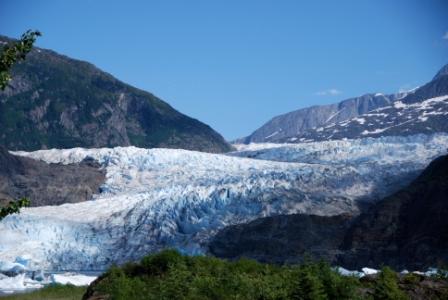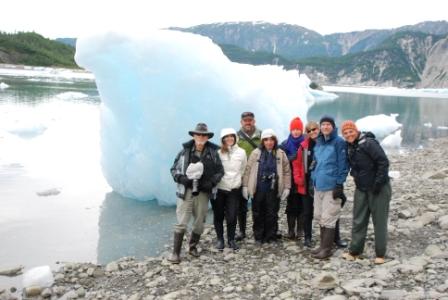By Wendy Worrall Redal
Standing at the rail of the Glacier Queen, we were riveted to the face of the 300-foot-high wall of ice towering before us. Though it was a quarter-mile away, we could hear every crack and crumble as the active tidewater glacier heaved and sloughed ice into the frigid waters of Prince William Sound.
Miniature icebergs called "growlers" bobbed around our boat, popping like Rice Krispies, but we were intent on a greater spectacle: waiting for a huge shard of ice to calve from the glacier's face and crash into the sea, the gray water exploding in fury of sound and spray.
Those of us on the Glacier Queen that day in the early 1980s had no idea that we were witnessing a phenomenon that travelers to follow would not see. For Alaska's monumental Columbia Glacier was beginning a rapid retreat. Over the next few years, the glacier began receding at a rate so breathtaking that boats could no longer come anywhere near it, so choked was the bay by the mass of ice spawned from the glacier's collapsing face.
While scientists tracking climate change had predicted such a fate, it's taken much of the populace some three decades since to understand how a warming atmosphere is hastening the loss of the planet's glaciers and icefields. The recent documentary Chasing Ice, which charts the work of photographer James Balog's Extreme Ice Survey monitoring ice loss through time-lapse imagery, provides an astounding visual account of what's happened to Columbia Glacier in recent years.
Since the 1980s, the glacier has retreated more than 12 miles and lost about half its total volume. Not every receding glacier is diminishing at the pace Columbia is, but the planet's ice is melting quickly enough that travelers who want to see it should make "glacier tourism" a top priority. Glaciers in the Alps are disappearing very rapidly, and some glaciologists predict they will be gone entirely in the next 20 to 30 years. Likewise, Montana's Glacier National Park may soon need a new name.
So, it may be time to bump up some of the planet's glaciers to the top of your travel bucket list. If you have kids, take them, too, as there will unquestionably be a lot less ice to view by the time they are grown up and able to afford their own travels. Here are five places to start, for spectacular glacier gazing.
- Holgate Glacier, Kenai Fjords, Alaska - Alaska's abundant glaciers are a top traveler draw. While Glacier Bay is perhaps best known, Kenai Fjords National Park offers a more intimate vantage point from a small boat, away from large cruise ships. Come face to face with massive Holgate and Aialik tidewater glaciers, as well as the abundant marine life of Resurrection Bay, on a day boat cruise from Seward or as part of a larger Alaska wildlife adventure.
Wendy Worrall Redal is the Editorial Director for Natural Habitat Adventures, a wildlife and nature tour operator based in Boulder, CO

